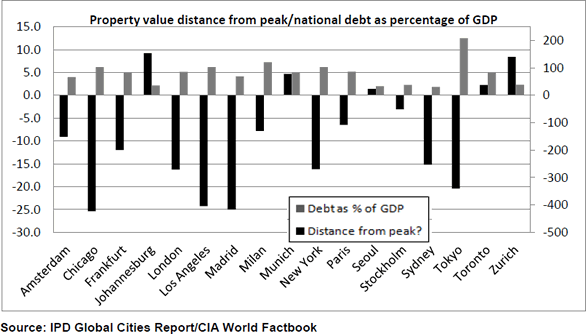Property values head north in South Africa as Johannesburg outperforms London, New York and Eurozone crisis drives returns in new safe-havens
 Peter Hobbs, Senior Director, Group Business Development at IPD
Peter Hobbs, Senior Director, Group Business Development at IPD
It claims to be the lightning capital of world, but however dubious this title may be, Johannesburg has avoided being struck by the global property crash as its offices, shops and warehouses outperformed those in every other global city outside of South Africa over the last decade.
Commercial property is a key measure of economic vitality, since strong retail, leisure and industrial performance encourages investors such as pension funds to buy up buildings to earn income through rental income and capital value increases.
Capital value appreciation in Johannesburg has hit 7.5 per cent over the ten years to 2011, compared to 3.6 per cent percent for New York, 2.2 per cent percent for London and -0.1 per cent percent for Munich over the same period.
Like Johannesburg, Sydney, Melbourne and Seoul remain (relatively) untainted by European contagion and investor appetite has been growing in these locations.
However, despite their growth over the last ten years, 2011 saw returns in the more conventional investment locations of London and New York improve considerably, as investors searching for safe havens put increasing pressures on limited stock. Last year, values in London rose by 6.0 per cent, in New York by 8.6 per cent and in Munich by 3.6 per cent - whilst in Johannesburg saw growth slow to just 0.4 per cent.
Peter Hobbs, IPD’s senior director, said, “The picture for global real estate is a tale of havens and have-nots. Institutions want safety, and at the minute, that means low-yielding prime office or retail in safe haven pockets around the world.”
“As a result, there’s been a real polarisation between the likes of Dublin and Madrid against the financial centres of London and New York, and the commodity rich cities of Calgary, Perth and Capetown.”
“Unlike gold or other commodities, real estate is a living, breathing asset that generates income through its tenants. Properties with good leases held by strong tenants tend to be attractive to institutions sheltering from the volatility of global markets.”
“It is for these reasons that these two different types of market have tended to perform well over the past couple of years. On the one hand, the financial centres of London and New York benefit from the quality of real estate and tenants as well as market transparency and liquidity that has attracted capital from many global investors. On the other hand, the commodity-driven cities of Australia, Canada and South Africa have benefited from the strong fundamental demand for real estate in these markets.”

Tourism, GDP, exchange rates and national debt can also impact heavily upon property performance – and over the past decade this has improved the returns of a number of European cities. However, in 2011, whilst the rest of the world pulled itself further out of recession, continuing doubts over the single currency impacted on European returns. As a result, last year Europe held 18 of the bottom 20 spots in 2011 (as measured by total return) in IPD’s Global Cities Report, which tracks the performance of 60 cities around the world.
Italy, Portugal and Ireland all have a high proportion of national debt as a percentage of GDP – thus returns in their cities have suffered from austerity and uncertainty, and the same applies to Japan, where debt amounts to over 200% of GDP.
North American cities made up the majority of the top 10 last year, although this is partly due to their property cycle lagging behind Europe’s by about 12 months, meaning slowing returns could be around the corner.
Net investment into property – including purchases and spending on developments or refurbishments, versus sales and other receipts – was positive at $30.3 billion in 2011, and increase of 80 percent compared with the sum of $16.8 billion in 2010.
Investors may have gained confidence in property but they had a very narrow focus in 2011: London, New York, Paris and Tokyo all topped the list (as measured by highest levels of net capital flows in USD, 2011).
Net capital flows were heavily negative for much of the Eurozone, with Madrid and Rome suffering particularly. German cities, notably Berlin and Munich, also featured as centres of strong divestment, rather than achieving a safe-haven status.
Over a 10-year period, Johannesburg and Cape Town saw the strongest growth in property values around the world of 7.5% and 9.7% percent.
However, over a five year period, Vancouver has seen the strongest capital value growth, of 2.5 percent (Johannesburg and Cape Town came second and third).
In 2011, the strongest capital growth was seen in Calgary, at 13.7 percent, due mainly to its booming oil trade and severely restricted supply of property.
Over the last five years, 48 of the 60 cities measured have suffered from negative capital movements.
Dublin delivered the highest income return in 2011, at 10.1 percent - the only city in the history of the report to deliver double-digit income. But this is due to a collapse in property values, distorting the income-value ratio in favour of high-risk, speculative investment.
Before the crash, German cities generally delivered the worst returns for investors.
Only a select few cities around the world have values above their pre-recession peaks – among them Johannesburg, Cape Town, Zurich, Munich, Toronto and Seoul, whilst Dublin has remained bottom of the list for three consecutive years.
London outpaced all other European cities in 2011, as international investors continued to pour cash into the Capital.
Phil Tily, UK managing director of IPD, said: “London’s transparency and liquidity have cemented its prime location status for international money, despite the slowdown affecting the rest of the UK. Private equity investors and cash rich buyers have kept pressure on prices and the slowdown in Europe has reinforced London’s position as the prime European destination for investment.”

“However, the influence of the Eurozone crisis on the London occupier market is the main worry for investors. With supply remaining tight and rents at relatively affordable levels in real terms, rental values should be growing. Instead, rental value growth has slowed this year, and that is bringing the Capital’s low yield levels into question.” "We think that, at least initially, a significant portion of these capital flows will target high quality assets, located in Europe's main cities such as London and Paris."
Michael Stancombe, co-chair of global real estate at law firm Hogan Lovells, expanded on international investment in London: “In terms of deal flow, we have seen huge levels of interest from global investors looking to invest capital in central London offices. The main driver appears to be preservation of capital combined with London's safe haven jurisdiction. It is gratifying that the strength of the underlying legal system is recognised in this equation.” “Within that range of capital, we have certainly seen an increased weight of money from Eurozone countries (such as Italy) coupled with growing Sovereign Wealth fund interest. In addition there continues to be significant interest from US investors.”
But, Bart Gysens, head of property research at Morgan Stanley, warned of the effects of impending regulation "We expect further insurance sector lending/investment in the commercial real estate space, amounting to potentially €50-100bn across Europe over the next 5-10 years. However, exact timing and trajectory remains uncertain and much depends on the final rules on asset capital requirements under Solvency 2." "Solvency 2 will require insurers to hold significant capital against duration gaps between assets and liabilities. Long-term assets such as commercial mortgages could offer an attractive solution to cover the duration gap. However, the exact level of capital requirements on these assets are yet to be finalised, and until there is greater clarity on Solvency 2 rules, which may not come until 2014-2015, we would not expect insurers to make substantial changes to their asset allocation approach. This may mean that the increase in near-term investment by insurers in commercial real estate lending may be limited."














